The Greatest Harryhausen: The Golden Voyage of Sinbad
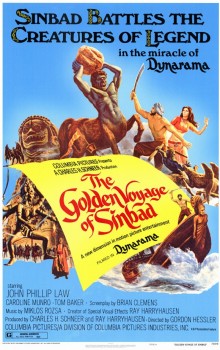 The Golden Voyage of Sinbad (1974)
The Golden Voyage of Sinbad (1974)
Directed by Gordon Hessler. Starring John Philip Law, Tom Baker, Caroline Munro, Douglas Wilmer, Martin Shaw, Kurt Christian, Grégoire Aslan, Takis Emmanuel.
“Every voyage has its own flavor.”
Recently on this blog, I wrote about one of the more ignored of Ray Harryhausen’s films, The 3 Worlds of Gulliver. This inspired me to review two other films of his that don’t get enough attention—the underwhelming H. G. Wells adaptation The First Men in the Moon (1964), and the wonderful but financially unsuccessful The Valley of Gwangi (1969)—on my own blog. Now I think I owe the legendary effects animator and fantasy film producer some time with one of his most popular films.
The Golden Voyage of Sinbad is not only one of Harryhausen’s most financially successful movies, but is also, in my Harryhausen-loving fan-obsessed opinion, the greatest piece the special effects maven ever worked on. I think that it’s not only Harryhausen’s best movie, but also one of the finest heroic fantasy films ever made.
Morningside Productions, Harryhausen’s and his producing partner Charles H. Schneer’s company, had experienced a financial disappointment with 1969’s “cowboys ropin’ a dinosaur” adventure The Valley of Gwangi, and the gap between it and The Golden Voyage of Sinbad was the longest yet between their movies. The two men decided to turn the clock back and re-visit the figure who had brought them to prominence in the first place: Sinbad the sailor. The major success of 1958’s The 7th Voyage of Sinbad had allowed them to take the path of colorful fantasy and period science fiction, and the character was one who could have a variety adventures. Harryhausen had done some sketches in 1964 for a new Sinbad story, and now had the opportunity to realize the project. Both those early sketches reached the final film almost unchanged.
Once Schneer felt that Harryhausen had created a detailed enough step-outline for a script, he brought on Brian Clemens, the creator of The Avengers (the British TV show, not the U.S. superhero team) and later director of Captain Kronos, Vampire Hunter (1974), to craft the screenplay. The final script is the best for a Harryhausen project, with shaded characters and a feel for the fantasy period. The plot is a typical “quest tale” with magic items leading to a great treasure. Captain Sinbad (John Phillip Law) sails to the lost island of Lemuria to find the third piece of an amulet that will lead to a pack of treasures and magical gifts and other assorted goodies. Going along with him on the voyage are the Vizier of Marabia (Douglas Wilmer), who wears a golden mask to hide his burned face; the beautiful serving girl Margiana (Caroline Munro), whose tattoo of an eye on her palm may have a connection to a dream of Sinbad’s; and lazy young Haroun (Kurt Christian), a comic relief character who comes as a package deal with Margiana. Opposing Sinbad is Prince Koura (Tom Baker), skilled in the black arts, who has plagued Marabia in his quest to learn the route to Lemuria.
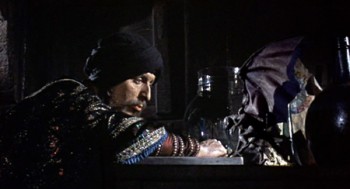 The story is enough to glue the picture together, although the script makes a Chex Party Mix of various folklores and mythologies, and what Sinbad and Koura are initially seeking seems vague. The map created by the merger of the two pieces of the amulet, one in Sinbad’s possession and the other in the Vizier’s, lead them to the Oracle of All Knowledge in Lemuria (the brief, VFX-heavy part was performed by Robert Shaw, who took a day out of his vacation in Spain to wear strange make-up and speak the obscure prophecy). This information takes the heroes to the Temple of the Green Men, and then to an ersatz underground Fountain of Eternal Youth. Koura stays in pursuit, causing all kinds of trouble while he keeps unnaturally aging himself with each magic spell he casts. Haroun provides humor along the way as he learns heroism, and surprisingly the comedy is unobtrusive.
The story is enough to glue the picture together, although the script makes a Chex Party Mix of various folklores and mythologies, and what Sinbad and Koura are initially seeking seems vague. The map created by the merger of the two pieces of the amulet, one in Sinbad’s possession and the other in the Vizier’s, lead them to the Oracle of All Knowledge in Lemuria (the brief, VFX-heavy part was performed by Robert Shaw, who took a day out of his vacation in Spain to wear strange make-up and speak the obscure prophecy). This information takes the heroes to the Temple of the Green Men, and then to an ersatz underground Fountain of Eternal Youth. Koura stays in pursuit, causing all kinds of trouble while he keeps unnaturally aging himself with each magic spell he casts. Haroun provides humor along the way as he learns heroism, and surprisingly the comedy is unobtrusive.
The plotting is a bit sloppy, but no more so than in the style of a “one thing after another” movie serial. What really makes Clemens’s script work is its feel for the Sir Richard Burton-style of English “Orientalism.” The aura Clemens creates through dialogue full of maxims, aphorisms, and exotic turns of phrase (“You are also a thief, and a thief is a king until he is caught!”) is that of a nineteenth-century version of The Thousand and One Nights, and it helps to create an aura of the fantastic for Harryhausen to work his magic. According to Harryhausen, an expert on Arabian folklore apparently lent a hand with some of the aphorisms, such as the thrice-told joke, “Trust in Allah . . . but tie up your camel.”
Harryhausen and Schneer were astute in the choice of Gordon Hessler to helm the picture. Hessler does the finest directorial work ever work on a Harryhausen movie. These films aren’t “director’s films” because the tight budget and the emphasis on special effects scenes means that most of the action has already been carefully plotted and boarded before the director even starts, and the scriptwriting arises out of “sweatbox sessions” that have to work in tandem with budget and VFX requirements. Consequently, most directors on the Harryhausen-Schneer epics are journeymen instead of auteurs. But Hessler, who started in British horror films like Scream and Scream Again and The Oblong Box, was the total package: he brought enormous vision to the picture, operated well within Harryhausen’s requirements, collaborated on script development, and did superb work with actors. Hessler shows a feel for the material that’s missing in some of the other movies in the series (compare it to the follow-up, Sinbad and the Eye of the Tiger, where Sam Wanamaker directs the movie like an episode of Columbo). Hessler must have loved the fantasy of the production, and the adoration comes through in the final product. A shame he couldn’t later get KISS Meets the Phantom of the Park (1978) to work the same way, but look what he had to work with.
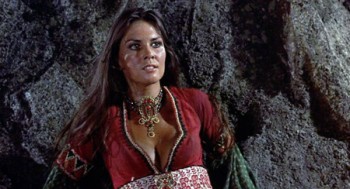 Although Harryhausen and Schneer grabbed some large-name British talent in a some of their films, most notably the “Royal Shakespeare Company + Burgess Meredith” cast of Clash of the Titans, they never got such a stellar ensemble as they did here. Hessler’s work with the actors deserves much of the credit, but the casting process picked up performers who had as much affinity for the material as the director and screenwriter. The late John Philip Law is the best of the three Sinbads from the Harryhausen-Schneer films; he’s lithe and pantherish in his movements, has a suave haughtiness and sense of humor, and an exotic intonation that is perfect for the part. Supporting Law’s Sinbad is Douglas Wilmer as the Vizier. Wilmer has to do most of his performance with his body and voice because of the gold mask that covers him. I love Caroline Munro as Margiana, and my reasons are not for discussion on this website.
Although Harryhausen and Schneer grabbed some large-name British talent in a some of their films, most notably the “Royal Shakespeare Company + Burgess Meredith” cast of Clash of the Titans, they never got such a stellar ensemble as they did here. Hessler’s work with the actors deserves much of the credit, but the casting process picked up performers who had as much affinity for the material as the director and screenwriter. The late John Philip Law is the best of the three Sinbads from the Harryhausen-Schneer films; he’s lithe and pantherish in his movements, has a suave haughtiness and sense of humor, and an exotic intonation that is perfect for the part. Supporting Law’s Sinbad is Douglas Wilmer as the Vizier. Wilmer has to do most of his performance with his body and voice because of the gold mask that covers him. I love Caroline Munro as Margiana, and my reasons are not for discussion on this website.
But Tom Baker wins my personal award for the Best Performance in Any Ray Harryhausen Movie. Baker, who would soon take on the role of the Fourth (and most beloved) Doctor in the British TV series Doctor Who, has piercing eyes and a voice that demands that you listen—or die! He treats Koura’s villainy with gravity and constant brooding menace. He can handle Clemens’s lines like “Make obeisance to me!” with natural flair, and he makes Koura’s rapidly increasing age believably painful. Sinbad refers to the wizard as “a great black bat of man,” and he’s exactly right. There’s something akin to Bela Lugosi during his prime in the way Baker attacks the part (Harryhausen saw something of Conrad Veidt’s evil sorcerer from The Thief of Bagdad in him, one of the reasons he was cast), and he’s one of the finest evil wizards in cinema. He acts perfectly in his scene across from one of Harryhausen’s stop-motion creations, the tiny winged homunculus the wizard uses to spy on his adversaries.
The homunculus is the first stop-motion marvel to appear in the movie, flying over Sinbad’s ship with one section of the amulet that will drive the plot in its claws. But its major scene occurs when Koura creates a second one after the destruction of the first. This is a good example of Harryhausen creating a real “performance” through his animation, as the homunculus gropes to life and then nervously paces before Koura before it decides it can trust and serve the man.
The second “wonder” to appear is the female-shaped figurehead of Sinbad’s ship that Koura animates so it can retrieve a map that he needs. This is relatively the weakest VFX sequence, which means it’s still very good. The limitation of the figurehead’s movement on the cramped deck of the ship means the scene can’t break out and go wild, and a wooden monster by necessity is going to move stiffly. However, the moment when one of sailors buries an axe into the figurehead’s chest is a great bit; Harryhausen exchanges the weapon in the actor’s hand in the live footage for a miniature one jammed into the model of the figurehead on his animating table so smoothly that you need to watch frame-by-frame on DVD to catch the switch.
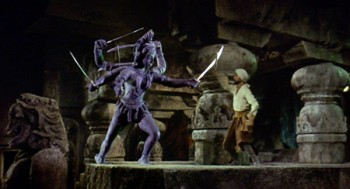 The movie’s unforgettable scene pits Sinbad and his crew against a six-armed statue of the Hindu goddess Kali, which Koura animated with one of elixirs. Koura initially brings the statue to life to make the Green Men cower before him, and he has Kali perform a dance that was specially choreographed by a respected Indian dancer. But this is only the warm-up. When Sinbad later corners Koura in the cave, Koura hurls his sword to Kali, who then produces five more blades in her hands and goes to town.
The movie’s unforgettable scene pits Sinbad and his crew against a six-armed statue of the Hindu goddess Kali, which Koura animated with one of elixirs. Koura initially brings the statue to life to make the Green Men cower before him, and he has Kali perform a dance that was specially choreographed by a respected Indian dancer. But this is only the warm-up. When Sinbad later corners Koura in the cave, Koura hurls his sword to Kali, who then produces five more blades in her hands and goes to town.
In Ray Harryhausen’s extensive catalog of visual effects sequences, I think that only the Medusa encounter in Clash of the Titans can beat the Kali duel. Although it involves a single creature, it required just as much work for the animator to execute as the skeleton brigade in Jason and the Argonauts. The immense complexity of a multi-armed living statue flashing around six swords in continual motion makes me wonder if Ray Harryhausen was completely insane to even attempt this. But I’m glad he did: the final product is breathtaking.
The story reaches its climax with two more monsters, a centaur and a gryphon. The centaur is only loosely linked to the Greek mythological version: this one is enormous, has blue skin, a single eye, and eats people. The gryphon appears suddenly in the conclusion to represent the side of good (the creature had a better build-up in earlier versions of the script), and the two beasts get involved in an exciting tussle before the Fountain of Destiny. This is another sequence that must have required intense patience to finish, with hooves, wings, tails, arms, and mouths in constant motion.
But Harryhausen still has one more effects sequence to go after the death of the two beasts (and the centaur goes rather nastily). Koura duels Sinbad to the death, but through the magic of the Fountain of Destiny he makes himself invisible except for his sword. The dancing scimitar in the air is achieved wonderfully, making for an exciting fantasy swordfight.
Harryhausen’s work on The Golden Voyage of Sinbad was phenomenal enough that it won the Oscar for Best Visual Effects that year… wait, let me check my notes. Oh, I’m sorry. It wasn’t even nominated. The winner that year was Earthquake. Kill, Kali! Kill our enemies! Kill them all!
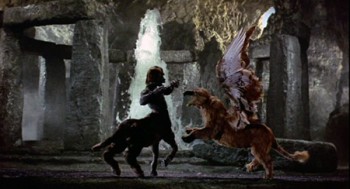 The film has excellent visuals even away from the effects work. The filmmakers had originally planned to shoot in India to fit with the designs, but ultimately they went for the familiarity of Spain, the location for most of the previous Harryhausen-Schneer films, for principal photography. The location work in Majorca and Madrid turned out splendid, showing why Spain was to fantasy filmmaking then what New Zealand is to it now. Cinematographer Ted Moore, a veteran of the early James Bond movies, created a realistic appearance that contrasts with the candy-colored look of The 7th Voyage of Sinbad. It’s the right dose of the real amidst the fantastic, and Moore is one the finest low-key photographers in the history of the medium. (In fact, From Russia with Love and The Golden Voyage of Sinbad have a remarkably similar appearance.)
The film has excellent visuals even away from the effects work. The filmmakers had originally planned to shoot in India to fit with the designs, but ultimately they went for the familiarity of Spain, the location for most of the previous Harryhausen-Schneer films, for principal photography. The location work in Majorca and Madrid turned out splendid, showing why Spain was to fantasy filmmaking then what New Zealand is to it now. Cinematographer Ted Moore, a veteran of the early James Bond movies, created a realistic appearance that contrasts with the candy-colored look of The 7th Voyage of Sinbad. It’s the right dose of the real amidst the fantastic, and Moore is one the finest low-key photographers in the history of the medium. (In fact, From Russia with Love and The Golden Voyage of Sinbad have a remarkably similar appearance.)
Harryhausen and Schneer were often fortunate in the composers they managed to hire, and for The Golden Voyage of Sinbad they got Miklós Rózsa out of semi-retirement to provide the sweeping, grandly romantic Arabian sound to match the images. Rózsa’s score isn’t as creative as Bernard Herrmann’s from The 7th Voyage of Sinbad, but it has the feel of the 1940s fantasy films that Rózsa did for Alexander Korda, such as The Thief of Bagdad, before he turned into principally a film noir and Biblical epics composer. It must have been a wonderful visit to an old friend for Rózsa, and the music sounds like he had a grand time, even with the reduced orchestra size.
The Golden Voyage of Sinbad made up for the failure of The Valley of Gwangi when it turned into a significant international hit. It came at the right time, in a mid-‘70s desert of fantasy films right before Star Wars changed everything. Harryhausen has great affection for it among his films: “. . . as far as I am concerned, it is another personal favourite, one in which all the ingredients came together successfully.” Schneer and Harryhausen moved quickly to make a new Sinbad film, Sinbad and the Eye of The Tiger, which came out in the 1977—and unfortunately does wrong almost everything that The Golden Voyage does right. Amazingly, although the sequel cost three times the amount of The Golden Voyage of Sinbad, it looks far shabbier.
More than thirty years after its premiere, The Golden Voyage of Sinbad still has the special glow of childhood fantasy, seeing artists working together to create a film that transports the viewer to another place and time for one hundred wonderful minutes.
Now, death to our enemies, Kali!
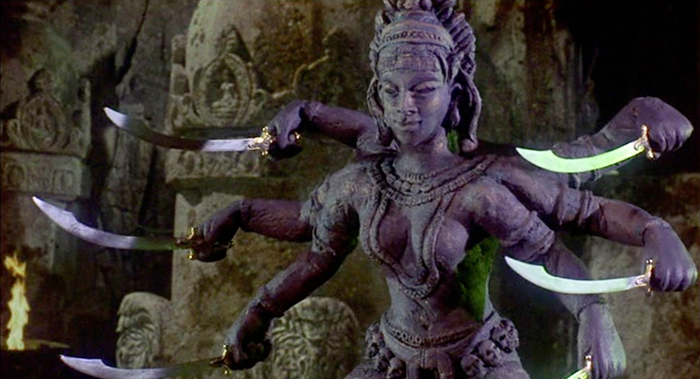
Ryan Harvey is a veteran blogger for Black Gate and an award-winning author. He received the Writers of the Future Award in 2011 for his short story “An Acolyte of Black Spires,” and has two stories forthcoming in Black Gate and a number of ebooks on the way. You can keep up with him at his website, www.RyanHarveyWriter.com and follow him on Twitter.
It’s funny: Just yesterday I put this in my Netflix queue because I figured my boys are old enough to enjoy it.
My favorite Harryhausen for all the reasons you mention. 7th Voyage is too ’50s, too clean and manicured, with Kerwin Mathews too central casting; and Eye of the Tiger lacks any charisma or tension (a giant walrus? Really? Your idea of fantasy adventure is a battle with a giant walrus?). But Golden Voyage captures the exoticism perfectly: the men have beards and wear turbans; everyone shimmers in their sweat; Law embodies the seafaring rogue of the stories using cleverness and swashbuckling to save the day; and Munro fascinates with her dark eyes and tunic open to the South Pole. And Baker! He and his basso profundo steal every scene he’s in.
Great review. Didn’t realize that was Robert Shaw as the Oracle, nor that it was shot in Spain — just like another favorite film of mine set during days of high adventure.
Childhood would not have been the same without these Harryhausen movies. Been too long since I’ve seen this, thanks for the reminder.
Based on the fond memories of adolescence, I bought a bunch of the Harryhausen movies in my late 20s. Golden Voyage is the only one I kept, and it still gets watched. Great movie.
But. I have never liked the centaur/griffin battle, and I’ve always found the oracle embarrassingly bad.
Ryan, I’d be interested in your take on Captain Kronos, Vampire Hunter. I’ve watched it 1.5 times and don’t yet know whether I like or not (meaning it will probably have to get netflixed this winter).
My opinion on Captain Kronos, Vampire Hunter? That’s an easy one, I wrote a review of it a few years ago:
http://www.swordandsorcery.org/mov-captainkronos.asp
I remember seeing this one in a local theater as a kid! Inspired weeks and weeks of my brother and I “playing Sinbad.”
Excellent review, Ryan!
I was just talking to someone about the Kali duel in this. There’s something about the sense of presence and solidity to the statue that I feel like is rarely recaptured in other films, especially CGI-heavy stuff.
Thanks, Ryan. And I see you love Miss Munro in that one, too. 🙂
Yes, I’m definitely in the ”‘70s Caroline Munro” fanclub. I love how she flirts with 007 while trying to gun him down from a helicopter in The Spy Who Loved Me—shame she wasn’t in it more!
Braak, you’re very right about the solidity of Kali in that scene. She has a tremendous presence in it, a sense she could really slice n‘ dice you. I think it’s because her movements aren’t smoothed over the way CGI would be today that she seems more intimidating—as if a wizard really were controlling her, and not people at a computer.
[…] It Came from Beneath the Sea, had scored two major successes with Sinbad movies during the 1970s, The Golden Voyage of Sinbad (1974) and Sinbad and the Eye of the Tiger (1977). The second one, however, was not one of their higher […]
[…] H. Schneer films, which were never known for clever screenplays (although I’ve made a case for The Golden Voyage of Sinbad). But the Harryhausen-Schneer movies have the trouble of overly linear plots based around the […]
[…] blackgate.com […]
[…] #split {}#single {}#splitalign {margin-left: auto; margin-right: auto;}#singlealign {margin-left: auto; margin-right: auto;}#splittitlebox {text-align: center;}#singletitlebox {text-align: center;}.linkboxtext {line-height: 1.4em;}.linkboxcontainer {padding: 7px 7px 7px 7px;background-color:#eeeeee;border-color:#000000;border-width:0px; border-style:solid;}.linkboxdisplay {padding: 7px 7px 7px 7px;}.linkboxdisplay td {text-align: center;}.linkboxdisplay a:link {text-decoration: none;}.linkboxdisplay a:hover {text-decoration: underline;} function opensingledropdown() { document.getElementById(‘singletablelinks’).style.display = ”; document.getElementById(‘singlemouse’).style.display = ‘none’; } function closesingledropdown() { document.getElementById(‘singletablelinks’).style.display = ‘none’; document.getElementById(‘singlemouse’).style.display = ”; } 892 moviesRaiders of the Lost Ark story mapRaiders of the Lost Ark at Palace CenterTonightThe Golden Voyage of Sinbad movie poster by Olga Fischerová 1977Black Gate […]
[…] Home Video needs to get on that Blu-ray of The Golden Voyage of Sinbad. There has to be a decent demand for that. Ryan Harvey is a veteran blogger for Black Gate and an […]
[…] of the earliest movies I remember seeing in the theater (I was 6) was The Golden Voyage of Sinbad, but I’d no more count that as research than a viewing of Aladdin, although the former is an […]
[…] The Creation of the Homunculus from The Golden Voyage of Sinbad […]
The Golden Voyage of Sinbad will finally be getting a Blu Ray release in December on the Twilight Time label.
http://www.screenarchives.com/